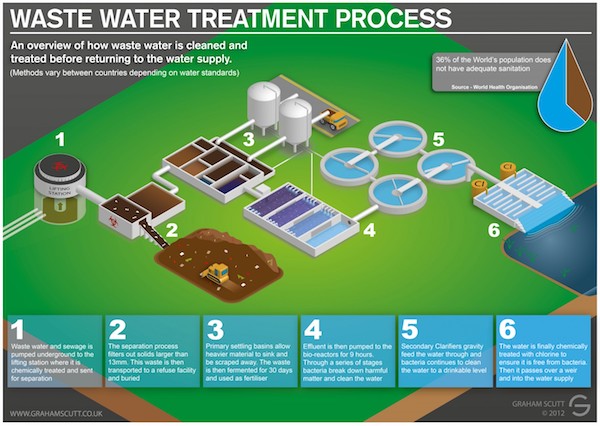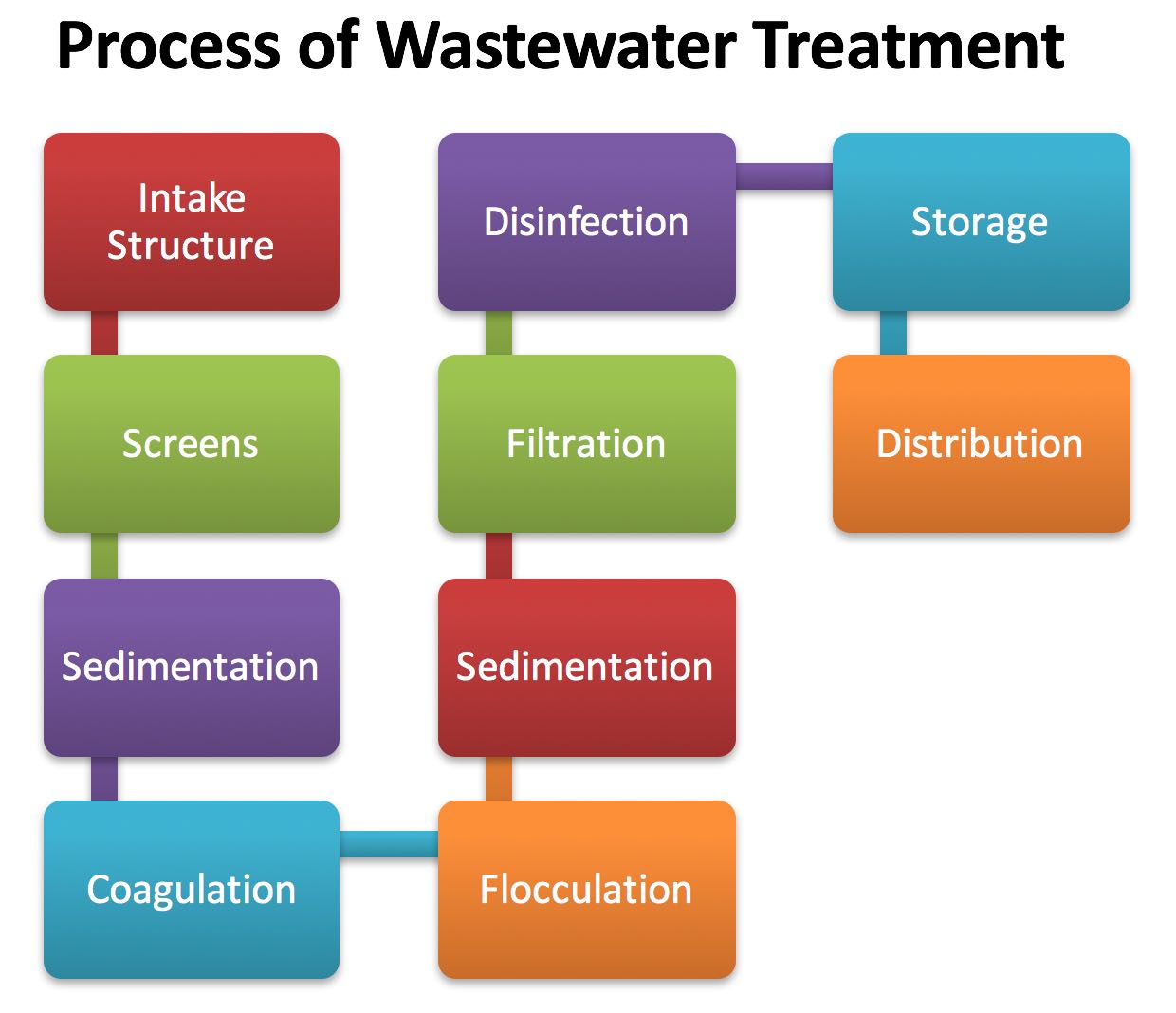................................................................................................................................................
Purpose and Methods of Treatment of Wastewater
By: Haseeb Jamal
Methods of Wastewater Treatment
 There are different methods of water treatment the selection of which depends upon the type of source & purpose of use of water.
There are different methods of water treatment the selection of which depends upon the type of source & purpose of use of water.
Following are the methods of waste water treatment:
Screening
Plain sedimentation
Coagulation & flocculation
Secondary sedimentation
Filtration
Disinfection
Aeration
Softening etc.
Treatment of Water
The prehistoric and the Old civilization established themselves near water sources.
While the importance of water quantity for drinking purposes was apparent to our ancestors, treatment processes was not well known.
The methods of Waste Water treatment originally focused on improving the aesthetic and Sight qualities of drinking.
Ancient Sanskrit & Ancient Greek writings recommended water treatment methods such as filtering through charcoal, exposing to sunlight, boiling, & straining.
During 1700's filtration was established as an effective means of removing the particles from water and treating it.
So, the earlier purification process was based on filtering the water to remove the Impurities & appearance of colloidal particles present (EPA 2000).
During the mid to late 1800, scientists gained a greater understanding of the sources & effects of drinking water contaminants, especially those that were not visible to naked eye.
In 1800's Louis Pasteur demonstrated the germ theory of disease, which explained how microorganism could transmit disease through media like water.
During the late nineteen & twentieth century's concerns regarding drinking water quality continued to focus mostly on disease causing microbes known as pathogenic bacteria in public water supplies.
It was known that turbidity is not only the aesthetic problem, particles in source water such as fecal matter, could harbor pathogens. Therefore, filtration was established as an effective means of removing these particles.
The clean & reliable water supply requirement was not recognized, until the second half of nineteen century, when the nature of infectious disease was first recognized.
The water supply becomes the major source to transmit these diseases. Therefore, proper treatment of water becomes essential.
The process of making water suitable for certain use such as domestic, industrial or any other use is called treatment of water.
The degree & type of treatment depends on the source of water & the purpose for which the water is required.
Generally, the water from surface source is treated conventionally to make it suitable for domestic as well as industrial use.
The ground water is generally suitable for drinking purposes but should be treated for industrial use to remove the hardness of water.
Purpose of Waste Water Treatment
It is desirable to treat water for a number of reasons including:
To prevent pathogenic microorganisms causing the disease.
To control unpleasant taste & appearance of particles.
To remove the excessive color of water & turbidity.
To extract the chemicals & dissolved minerals.
Procedures for Waste Water Treatment
 Despite the existence of a multitude of technological processes for production of water for potable or other uses, the general principles of purification are approximately the same.
Despite the existence of a multitude of technological processes for production of water for potable or other uses, the general principles of purification are approximately the same.
These principles provide the following range of the primary procedures:
Removal from the water of heterophase contaminants by sedimentation or coagulation & sedimentation, filtration, &, less often, flotation. As a result of such treatment, water turbidity & color index are reduced.
Elimination of admixture of active pathogenic bacteria & prevention of their reproduction (disinfection of water) by chlorination, iodination, Ozonation, silvering, electro-magnetic radiation, & electro chemical & other methods.
Adjustment of water composition in dissolved (homophase) admixtures. This stage can include a large diversity of technological processes depending on the composition & quality of initial water. First, this includes the elimination of smell, taste. & toxic trace pollutant of water by methods of aeration & degassing, oxidation, adsorption, & removal from the water of iron, manganese, silicon, & fluorides.
The final stage of water treatment might include water fluorination & softening (hardness removal).
In regions with a deficiency of freshwater but availability of sources of brackish & saline water, it may also be necessary to carry out water desalination.
Special water treatment, for example by radiation method, as well its purification from specific contaminants including radioactive matters or particular highly toxic chemicals.
The processes & technologies used to remove the contaminants from water & to improve its quality is recognized all over the world.
The choice of which treatment to use from a great variety of available processes depends on the characteristics of the water, the type of the water quality problems to be present, & the costs of different treatments.
Methods of Waste Water Treatment Process
As pointed out earlier that all the above techniques may or may not be used for treating particular nature of water.
The necessity of a few or all of these treatments depends solely upon the quality of available raw water.
Before we describe these techniques in details, let us summarize the functions served by each of these techniques in effecting purification of raw water.
Most of the big & visible objects, such as trees, branches, sticks, vegetation, fish, animal life etc., present in raw water of surface material can be removed by bar & screen operations. This process is called screening.
The coarser suspended material can then be removed by letting the water settle in sedimentation basins. The process is called plain sedimentation.
The effectiveness of sedimentation may however, be increased by mixing certain chemicals with water, to form flocculent precipitates, which carries the suspended particles as it settles. The process is called chemical coagulation.
The finer particles in suspension, which may avoid settling in sedimentation basins even after using the chemical coagulation, may then be removed by filtering the water through filters. This process is called filtration
Filtered water that may still contain pathogenic bacteria is then made bacteria-proof by adding certain chemicals such as chlorine etc. This process of killing of germs is called disinfection.
The resulting water, though now becomes safe, yet may not be attractive to the tongue of consumers.
Unpleasant tastes & odors may then, therefore, have to be removed by adding certain chemical compounds such as activated carbon. This process is called adsorption.
The resulting water may sometimes be much harder than permissible level & may, therefore, have to be softened by process called the softening.
Sometimes, the resulting water may be given further treatment, such as
fluoridation (i.e. the addition of soluble fluoride for controlling dental caries),
liming (i.e. addition of lime in order to control acidity & reduce the corrosive action),
re-carbonation (i.e. addition of carbon dioxide so as to prevent deposition of calcium carbonate scale), the
desalination (i.e. removal of excessive salt, if present)
I am a Civil Engineer, graduated from University of Engineering and Technology, Peshawar, Pakistan in 2010. I also have a PG-Diploma in Disaster Management and MS in Urban Infrastructure Engineering (In Progress). My expertise include civil related softwares like AutoCAD, SAP2000, MS Project, Primavera, MS Office and GIS. My technical skills include project management, monitoring and evaluation, structural assessment, disaster risk management, Quantity survey, land survey, material testing, site management and technical writing. I am trained in writing project progress reports as well as proposals and concept papers. I have also received advanced training on surveying, proposal writing, Monitoring and Evaluation of projects as well as organizations.
I have worked as Project Engineer at National Research and Development Foundation, Peshawar and CENCON Associates. I also worked with Spectra Engineering Solutions as Senior Civil Engineer in monitoring of World Bank and UNDP funded projects all over Khyber Pakhtunkhwa and FATA. Currently, I am working as Deputy Manager Development at NayaTel, Peshawar.

No comments:
Post a Comment